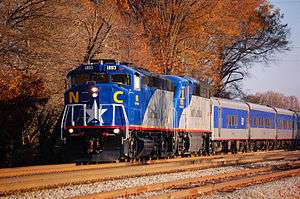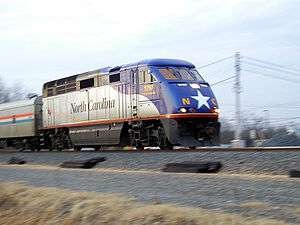EMD F59PH

The EMD F59PH is a four-axle 3,000 hp (2 MW) B-B diesel-electric locomotive built by General Motors Electro-Motive Division in two variants from 1988 to 2001. The original F59PH was designed in consultation with GO Transit for commuter operation in Toronto. The design was successful and became the backbone of GO Transit's fleet for two decades. Another major operator is Southern California's Metrolink, which launched with F59PHs in 1992. Production of the F59PH ended in 1994, with 73 locomotives built.
The F59PHI was designed for Amtrak California intercity service and began production in 1994. It is distinguished from the F59PH by its streamlined cab. A total of 83 F59PHIs were built between 1994–2001, primarily for commuter operators.
F59PH
| EMD F59PH | |||||||||||||
|---|---|---|---|---|---|---|---|---|---|---|---|---|---|
|
Two F59PH locomotives owned by GO Transit at Oakville station. GO has since discontinued the majority of these locomotives but a handful remain in regular service. Several ex-GO units are now operated by other services. | |||||||||||||
| |||||||||||||
| |||||||||||||
| |||||||||||||
| |||||||||||||
The F59PH was the first in the "F59" series of locomotives. 73 locomotives were built from May 1988 to May 1994 for two commuter transit railroads, Metrolink of Los Angeles, California, United States and GO Transit of Toronto, Ontario, Canada.[1] While Metrolink continues to use these locomotives today, in 2008, GO Transit began discontinuing operations using this locomotive in favour of the new MPI MP40PH-3C.[2] Only eight locomotives that were refurbished in 2011 remain in service, but will be replaced upon the delivery of the MPI MP54AC locomotives.
This locomotive is equipped with a turbocharged EMD 12-710G3A, a 12-cylinder, two-stroke Diesel engine (prime mover), front and rear platforms, a full-width cab with a three-piece windshield. Earlier EMD cowl-type locomotives had used a two-piece windshield, while the Canadian comfort cab used a four-piece design.[2]
The F59PH is still used today, mainly on commuter railroads. Metrolink has rebuilt 5 of their F59's with an upgraded cooling system, an upgraded 12-710G3Eco Tier 2 engine, and an E-bell, making them F59PHR. NCDOT 1859 is currently being built to this same standard in Southern California and will be completed in 2018.
Fleet details
| Operator | Number | Year built | Unit numbers | Comments |
|---|---|---|---|---|
| Exo | 10 | 1988-1990 | 1340-1349 |
|
| GO Transit | 8 | 1988–1994 | 557–564 | |
| Metra | 3 | 1988 | 97-99 |
|
| Metrolink | 23 | 1992–1993 | 851–873 |
|
| NCDOT | 6 | 1988-1990 | 1810, 1859, 1869, 1871, 1893, 1984 | |
| Trinity Railway Express | 8 | 1988–1994 | 525, 527, 528, 565–568 |
|
| RB Railway Group | 12 | 1988-1990 | 18520–18524, 18531, 18537–18538, 18547, 18551, 18554 |
|
F59PHI
| EMD F59PHI | |||||||||||||||||
|---|---|---|---|---|---|---|---|---|---|---|---|---|---|---|---|---|---|
 Amtrak/NCDOT RNCX EMD F59PHI #1797, "City of Asheville", leading the Piedmont north out of Charlotte, North Carolina on February 20, 2003 | |||||||||||||||||
| |||||||||||||||||
| |||||||||||||||||
| |||||||||||||||||
| |||||||||||||||||
The EMD F59PHI is a common diesel-electric locomotive on passenger trains in North America, built originally by General Motors Electro-Motive Division (EMD), now built by the successor company, Electro-Motive Diesel, which is owned by Progress Rail Services, itself a division of Caterpillar.
First built in 1994, the locomotive is a 3,200 hp (2.4 MW) B-B diesel-electric locomotive intended for service on North American mainlines.[3] This locomotive is equipped with a turbocharged EMD 12-710G3C-EC, a 12-cylinder, 2 stroke diesel engine (prime mover). The main (traction) alternator converts mechanical energy from the prime mover into electrical energy that is distributed through a high voltage cabinet to direct current traction motors. Each of the four traction motors is directly geared to a pair of driving wheels. The gear ratio of the traction motors (model D87BTR) to wheel axle determines the maximum operating speed of the locomotive; a standard F59PHI has a gear ratio of 56:21 which provides a top speed of 110 mph (180 km/h).
The F59PHI has a fully enclosed carbody which provides protected walkways for easy access to the engine room and trailing units. This arrangement allows routine maintenance while the locomotive is in service. The noteworthy aspect of this locomotive's exterior is the use of composites to present a streamlined appearance.[3]
To supply electrical power for passenger service, the F59PHI is equipped with a secondary electrical generator referred to as the Head End Power (HEP) unit. The head-end generator generates AC power at 480 V, 60 Hz AC, and can be rated between 500 and 750 kW (670 and 1,010 hp) to provide power to the passenger carriages for lighting, electric heating, and air conditioning. The head-end generator is powered by a second diesel engine dedicated to it. With this arrangement, the prime mover is not burdened by head-end power generation and consequently is used solely for supplying tractive effort.
When it debuted for Caltrans in late 1994, the F59PHI was the first locomotive in the United States which met California's stringent emission standards.[3]
Fleet details
| Operator | Number | Year built | Unit numbers | Comments |
|---|---|---|---|---|
| Amtrak | 21 | 1998[4] | 450–470 | Used on the Pacific Surfliner and Cascades services. They will be replaced by Siemens Charger locomotives from 2018-2020. The locomotives were sold to Metra in early 2018.[4] |
| 2 | 1998 | 1755, 1797 | Owned by NCDOT and used on the Piedmont | |
| 15 | 1994 | 2001-2009 | Owned by Caltrans and used on the San Joaquin and Capitol Corridor | |
| 2001 | 2010-2015 | |||
| Exo | 11 | 1340-1349 | Used on Vaudreuil–Hudson, Saint-Jérôme, and Candiac lines | |
| Metrolink | 14 | 1994-1995, 2001 | 874-887 | |
| North County Transit District (Coaster) | 2 | 2001 | 3001-3002 | |
| Sound Transit (Sounder Commuter Rail) | 11 | 1998-2001 | 901-911 | All locomotives rebuilt with engines that meet the Tier 3 EPA standard to reduce emissions and provide fuel savings.[5] |
| Trinity Railway Express | 2 | 2001 | 569-570 | |
| West Coast Express | 5 | 901-905 |
Accidents and incidents
On February 14, 2005, Amtrak F59PHI #458, pulling the Pacific Surfliner crashed into a tractor trailer at a grade crossing in Oxnard, CA. The accident resulted in zero deaths with no reported injuries, and the locomotive was quickly repaired and put back into service after the accident.[6]
Metrolink F59PH #855 was damaged beyond repair in the 2008 Chatsworth train collision and was subsequently retired from service and scrapped[7].
On February 24, 2015, Metrolink locomotive #870 was pushing (the locomotive was located at the rear) a passenger train that struck a vehicle obstructing the line at Oxnard, California and was derailed. The accident resulted in one person was killed and 29 others were injured.
On July 2, 2017, Amtrak locomotive #467 was involved in a derailment near Steilacoom, Washington. Minor injuries were reported, but no fatalities were confirmed after the derailment.
See also
Notes
- 1 2 McDonnell 2015, p. 208
- 1 2 Solomon 2011, p. 159
- 1 2 3 "F59PHI debuts in California". Railway Age – via HighBeam Research (subscription required) . December 1, 1994. Retrieved 2012-12-27.
- 1 2 "Metra moves to buy newer engines" (Press release). Metra. February 21, 2018.
- ↑ "MOTION NO. M2016-123 Sounder Locomotive Overhaul Contract Amendment" (PDF). Sound Transit. December 15, 2016. Retrieved February 25, 2017.
- ↑ "Amtrac (sic) Train Hits Truck - Oxnard, CA. Feb. 14, 2005". Retrieved March 31, 2018.
- ↑ "Pictures of SCAX 855". www.rrpicturearchives.net. Retrieved 2017-12-09.
References
- McDonnell, Greg (2015). Locomotives: The Modern Diesel and Electric Reference (2nd ed.). Richmond Hill, Ontario: Boston Mills Press. ISBN 978-1-77085-609-7.
- Solomon, Brian (2011). Modern Diesel Power. Minneapolis, MN: Voyageur Press. ISBN 978-0-76-033943-5.
Further reading
| Wikimedia Commons has media related to EMD F59PH locomotives. |
| Wikimedia Commons has media related to EMD F59PHI locomotives. |